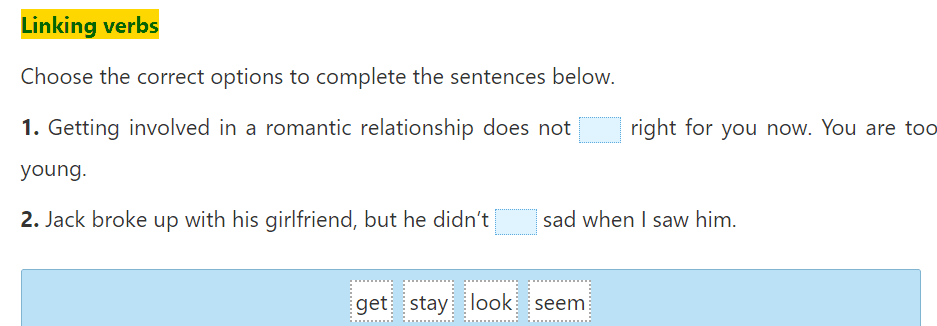Bài học cùng chủ đề
Báo cáo học liệu
Mua học liệu
Mua học liệu:
-
Số dư ví của bạn: 0 coin - 0 Xu
-
Nếu mua học liệu này bạn sẽ bị trừ: 2 coin\Xu
Để nhận Coin\Xu, bạn có thể:

Luyện tập SVIP

The aim of Review 1 is to help you to revise the language (vocabulary, grammar & pronunciation) and skills (reading, speaking, listening & writing) you have learnt in Units 1, 2 and 3.
 Ready, steady, go!
Ready, steady, go!
Vocabulary
Form compound nouns with the words in the box. Then complete the sentences, using the correct ones.
|
care child friend girl grand house parents point view work |
1. She spent all morning doing .
2. There are many different options available to mothers returning to work.
3. Parents should try to see things from a teenager's .
4. I have lived with my since I was born.
5. He can't come because he's taking his on a date.


Vocabulary
Complete the sentences with correct words from the box.
1. She has a close with her parents.
2. He broke the glass vase during a(n) with his cousin.
3. We were finally after he apologised.
4. My little cousin is becoming more so my aunt has more time for herself.
5. Teaching secondary school students to be independent and is important for their personal development.

(Kéo thả hoặc click vào để điền)
Pronunciation
Listen and pay attention to the linking between the consonant sounds and the vowel sounds. Choose the sentence you hear. Then practise reading the sentence.

Pronunciation
Listen and pay attention to the linking between the consonant sounds and the vowel sounds. Choose the sentence you hear. Then practise reading the sentence.
Pronunciation
Listen and pay attention to the linking between the consonant sounds and the vowel sounds. Choose the sentence you hear. Then practise reading the sentence.

Pronunciation
Listen and pay attention to the linking between the consonant sounds and the vowel sounds. Choose the sentence you hear. Then practise reading the sentence.

Pronunciation
Listen and pay attention to the linking between the consonant sounds and the vowel sounds. Choose the sentence you hear. Then practise reading the sentence.


Have a good day to you!
Lesson objectives
We're getting to know how to use should and shouldn't to express opinions and advice, and must and have to to express obligation.
 | DO YOU KNOW ... ? |
| We use should and shouldn't to give our opinions about something or advice to someone. | Chúng ta sử dụng should và shouldn't để đưa ra ý kiến, quan điểm về cái gì hoặc lời khuyên cho ai đó. |
| Example: I think parents should spend more time talking with their teenage children. | Ví dụ: Tớ nghĩ phụ huynh nên dành nhiều thời gian hơn để trò chuyện với con mình ở độ tuổi vị thành niên. |
| Ought to and ought not to mean the same as should and shouldn't. | Ought to và ought not to tương đương với should và shouldn't. |
| Example: I think she ought to share the housework with her mother. | Ví dụ: Tôi nghĩ bạn ấy nên giúp đỡ mẹ mình trong việc nhà. |
| Must has a stronger meaning than should and ought to. | Must có tính bắt buộc mạnh hơn should và shouldn't. |
| Must and have to are used to express obligation or the need to do something. | Must và have to được dùng để diễn tả tính bắt buộc hoặc cần thiết để làm việc gì đó. |
| Example: - You must show respect for the elderly. - I have to clean the floor and cook dinner every day. | Ví dụ: - Bạn phải tôn trọng người lớn tuổi. - Tôi phải lau sàn và nấu bữa tối mỗi ngày. |
| Must expresses obligation imposed by the speaker while have to expresses external obligation. | Must diễn tả tính bắt buộc mang tính chủ quan của người nói, còn have to diễn tả tính bắt buộc mang tính khách quan. |
| Examples: - You must practise your English every day. (a teacher telling a student) - I have to practise my English every day. (a student telling his/ her parents about school | Ví dụ: - Em phải trau dồi tiếng Anh của mình hàng ngày. (Giáo viên cảm thấy điều đó là cần thiết và nói với học sinh như vậy.) - Con phải trau dồi tiếng Anh của mình hàng ngày. (Một học sinh nói với bố mẹ về yêu cầu của trường học trong việc học tiếng Anh.) |
| Notes: | Chú ý: |
| Ought to is not as common as should and is a little more formal in questions and negatives. We use I don't think we should / ought to rather than I think we shouldn't / oughtn't to. | Ought to ít phổ biến hơn should và trang trọng hơn một chút so với should ở trong thể nghi vấn và phủ định. Chúng ta dùng I don't think we should / ought to thay vì I think we shouldn't / oughtn't to. |
| Example: I don't think you should invite your friends to stay | Ví dụ: Tôi không nghĩ bạn nên rủ bạn ngủ qua đêm. |
| In their negative form, mustn't and don't have to have different meanings. We use mustn't when an action is forbidden or prohibited. | Ở thể phủ định, mustn't và don't have to có nghĩa khác nhau. Chúng ta dùng mustn't khi hành động bị cấm. |
| Example: You mustn't cheat in the exams. | Ví dụ: Bạn không được phép gian lận trong kì thi. |
| We use don't have to when the action is not necessary. | Chúng ta dùng don't have to khi hành động không cần thiết. |
| Example: Students don't have to go to school on Sundays. | Ví dụ: Học sinh không phải đến trường vào thứ bảy. |
Grammar
Choose the correct answer.
It's a great film. You ____ go and see it.


Have a good day to you!
Lesson objectives
We're getting to know how to use should and shouldn't to express opinions and advice, and must and have to to express obligation.
 | DO YOU KNOW ... ? |
| We use should and shouldn't to give our opinions about something or advice to someone. | Chúng ta sử dụng should và shouldn't để đưa ra ý kiến, quan điểm về cái gì hoặc lời khuyên cho ai đó. |
| Example: I think parents should spend more time talking with their teenage children. | Ví dụ: Tớ nghĩ phụ huynh nên dành nhiều thời gian hơn để trò chuyện với con mình ở độ tuổi vị thành niên. |
| Ought to and ought not to mean the same as should and shouldn't. | Ought to và ought not to tương đương với should và shouldn't. |
| Example: I think she ought to share the housework with her mother. | Ví dụ: Tôi nghĩ bạn ấy nên giúp đỡ mẹ mình trong việc nhà. |
| Must has a stronger meaning than should and ought to. | Must có tính bắt buộc mạnh hơn should và shouldn't. |
| Must and have to are used to express obligation or the need to do something. | Must và have to được dùng để diễn tả tính bắt buộc hoặc cần thiết để làm việc gì đó. |
| Example: - You must show respect for the elderly. - I have to clean the floor and cook dinner every day. | Ví dụ: - Bạn phải tôn trọng người lớn tuổi. - Tôi phải lau sàn và nấu bữa tối mỗi ngày. |
| Must expresses obligation imposed by the speaker while have to expresses external obligation. | Must diễn tả tính bắt buộc mang tính chủ quan của người nói, còn have to diễn tả tính bắt buộc mang tính khách quan. |
| Examples: - You must practise your English every day. (a teacher telling a student) - I have to practise my English every day. (a student telling his/ her parents about school | Ví dụ: - Em phải trau dồi tiếng Anh của mình hàng ngày. (Giáo viên cảm thấy điều đó là cần thiết và nói với học sinh như vậy.) - Con phải trau dồi tiếng Anh của mình hàng ngày. (Một học sinh nói với bố mẹ về yêu cầu của trường học trong việc học tiếng Anh.) |
| Notes: | Chú ý: |
| Ought to is not as common as should and is a little more formal in questions and negatives. We use I don't think we should / ought to rather than I think we shouldn't / oughtn't to. | Ought to ít phổ biến hơn should và trang trọng hơn một chút so với should ở trong thể nghi vấn và phủ định. Chúng ta dùng I don't think we should / ought to thay vì I think we shouldn't / oughtn't to. |
| Example: I don't think you should invite your friends to stay | Ví dụ: Tôi không nghĩ bạn nên rủ bạn ngủ qua đêm. |
| In their negative form, mustn't and don't have to have different meanings. We use mustn't when an action is forbidden or prohibited. | Ở thể phủ định, mustn't và don't have to có nghĩa khác nhau. Chúng ta dùng mustn't khi hành động bị cấm. |
| Example: You mustn't cheat in the exams. | Ví dụ: Bạn không được phép gian lận trong kì thi. |
| We use don't have to when the action is not necessary. | Chúng ta dùng don't have to khi hành động không cần thiết. |
| Example: Students don't have to go to school on Sundays. | Ví dụ: Học sinh không phải đến trường vào thứ bảy. |
Grammar
Choose the correct answer.
You don't look well. You ____ go out. It's cold outside.


Have a good day to you!
Lesson objectives
We're getting to know how to use should and shouldn't to express opinions and advice, and must and have to to express obligation.
 | DO YOU KNOW ... ? |
| We use should and shouldn't to give our opinions about something or advice to someone. | Chúng ta sử dụng should và shouldn't để đưa ra ý kiến, quan điểm về cái gì hoặc lời khuyên cho ai đó. |
| Example: I think parents should spend more time talking with their teenage children. | Ví dụ: Tớ nghĩ phụ huynh nên dành nhiều thời gian hơn để trò chuyện với con mình ở độ tuổi vị thành niên. |
| Ought to and ought not to mean the same as should and shouldn't. | Ought to và ought not to tương đương với should và shouldn't. |
| Example: I think she ought to share the housework with her mother. | Ví dụ: Tôi nghĩ bạn ấy nên giúp đỡ mẹ mình trong việc nhà. |
| Must has a stronger meaning than should and ought to. | Must có tính bắt buộc mạnh hơn should và shouldn't. |
| Must and have to are used to express obligation or the need to do something. | Must và have to được dùng để diễn tả tính bắt buộc hoặc cần thiết để làm việc gì đó. |
| Example: - You must show respect for the elderly. - I have to clean the floor and cook dinner every day. | Ví dụ: - Bạn phải tôn trọng người lớn tuổi. - Tôi phải lau sàn và nấu bữa tối mỗi ngày. |
| Must expresses obligation imposed by the speaker while have to expresses external obligation. | Must diễn tả tính bắt buộc mang tính chủ quan của người nói, còn have to diễn tả tính bắt buộc mang tính khách quan. |
| Examples: - You must practise your English every day. (a teacher telling a student) - I have to practise my English every day. (a student telling his/ her parents about school | Ví dụ: - Em phải trau dồi tiếng Anh của mình hàng ngày. (Giáo viên cảm thấy điều đó là cần thiết và nói với học sinh như vậy.) - Con phải trau dồi tiếng Anh của mình hàng ngày. (Một học sinh nói với bố mẹ về yêu cầu của trường học trong việc học tiếng Anh.) |
| Notes: | Chú ý: |
| Ought to is not as common as should and is a little more formal in questions and negatives. We use I don't think we should / ought to rather than I think we shouldn't / oughtn't to. | Ought to ít phổ biến hơn should và trang trọng hơn một chút so với should ở trong thể nghi vấn và phủ định. Chúng ta dùng I don't think we should / ought to thay vì I think we shouldn't / oughtn't to. |
| Example: I don't think you should invite your friends to stay | Ví dụ: Tôi không nghĩ bạn nên rủ bạn ngủ qua đêm. |
| In their negative form, mustn't and don't have to have different meanings. We use mustn't when an action is forbidden or prohibited. | Ở thể phủ định, mustn't và don't have to có nghĩa khác nhau. Chúng ta dùng mustn't khi hành động bị cấm. |
| Example: You mustn't cheat in the exams. | Ví dụ: Bạn không được phép gian lận trong kì thi. |
| We use don't have to when the action is not necessary. | Chúng ta dùng don't have to khi hành động không cần thiết. |
| Example: Students don't have to go to school on Sundays. | Ví dụ: Học sinh không phải đến trường vào thứ bảy. |
Grammar
Choose the correct answer.
It's late. I ____ go now or I will miss the last train.


Have a good day to you!
Lesson objectives
We're getting to know how to use should and shouldn't to express opinions and advice, and must and have to to express obligation.
 | DO YOU KNOW ... ? |
| We use should and shouldn't to give our opinions about something or advice to someone. | Chúng ta sử dụng should và shouldn't để đưa ra ý kiến, quan điểm về cái gì hoặc lời khuyên cho ai đó. |
| Example: I think parents should spend more time talking with their teenage children. | Ví dụ: Tớ nghĩ phụ huynh nên dành nhiều thời gian hơn để trò chuyện với con mình ở độ tuổi vị thành niên. |
| Ought to and ought not to mean the same as should and shouldn't. | Ought to và ought not to tương đương với should và shouldn't. |
| Example: I think she ought to share the housework with her mother. | Ví dụ: Tôi nghĩ bạn ấy nên giúp đỡ mẹ mình trong việc nhà. |
| Must has a stronger meaning than should and ought to. | Must có tính bắt buộc mạnh hơn should và shouldn't. |
| Must and have to are used to express obligation or the need to do something. | Must và have to được dùng để diễn tả tính bắt buộc hoặc cần thiết để làm việc gì đó. |
| Example: - You must show respect for the elderly. - I have to clean the floor and cook dinner every day. | Ví dụ: - Bạn phải tôn trọng người lớn tuổi. - Tôi phải lau sàn và nấu bữa tối mỗi ngày. |
| Must expresses obligation imposed by the speaker while have to expresses external obligation. | Must diễn tả tính bắt buộc mang tính chủ quan của người nói, còn have to diễn tả tính bắt buộc mang tính khách quan. |
| Examples: - You must practise your English every day. (a teacher telling a student) - I have to practise my English every day. (a student telling his/ her parents about school | Ví dụ: - Em phải trau dồi tiếng Anh của mình hàng ngày. (Giáo viên cảm thấy điều đó là cần thiết và nói với học sinh như vậy.) - Con phải trau dồi tiếng Anh của mình hàng ngày. (Một học sinh nói với bố mẹ về yêu cầu của trường học trong việc học tiếng Anh.) |
| Notes: | Chú ý: |
| Ought to is not as common as should and is a little more formal in questions and negatives. We use I don't think we should / ought to rather than I think we shouldn't / oughtn't to. | Ought to ít phổ biến hơn should và trang trọng hơn một chút so với should ở trong thể nghi vấn và phủ định. Chúng ta dùng I don't think we should / ought to thay vì I think we shouldn't / oughtn't to. |
| Example: I don't think you should invite your friends to stay | Ví dụ: Tôi không nghĩ bạn nên rủ bạn ngủ qua đêm. |
| In their negative form, mustn't and don't have to have different meanings. We use mustn't when an action is forbidden or prohibited. | Ở thể phủ định, mustn't và don't have to có nghĩa khác nhau. Chúng ta dùng mustn't khi hành động bị cấm. |
| Example: You mustn't cheat in the exams. | Ví dụ: Bạn không được phép gian lận trong kì thi. |
| We use don't have to when the action is not necessary. | Chúng ta dùng don't have to khi hành động không cần thiết. |
| Example: Students don't have to go to school on Sundays. | Ví dụ: Học sinh không phải đến trường vào thứ bảy. |
Grammar
Choose the correct answer.
Students ____ use mobile phones in class.


Have a good day to you!
Lesson objectives
We're getting to know how to use should and shouldn't to express opinions and advice, and must and have to to express obligation.
 | DO YOU KNOW ... ? |
| We use should and shouldn't to give our opinions about something or advice to someone. | Chúng ta sử dụng should và shouldn't để đưa ra ý kiến, quan điểm về cái gì hoặc lời khuyên cho ai đó. |
| Example: I think parents should spend more time talking with their teenage children. | Ví dụ: Tớ nghĩ phụ huynh nên dành nhiều thời gian hơn để trò chuyện với con mình ở độ tuổi vị thành niên. |
| Ought to and ought not to mean the same as should and shouldn't. | Ought to và ought not to tương đương với should và shouldn't. |
| Example: I think she ought to share the housework with her mother. | Ví dụ: Tôi nghĩ bạn ấy nên giúp đỡ mẹ mình trong việc nhà. |
| Must has a stronger meaning than should and ought to. | Must có tính bắt buộc mạnh hơn should và shouldn't. |
| Must and have to are used to express obligation or the need to do something. | Must và have to được dùng để diễn tả tính bắt buộc hoặc cần thiết để làm việc gì đó. |
| Example: - You must show respect for the elderly. - I have to clean the floor and cook dinner every day. | Ví dụ: - Bạn phải tôn trọng người lớn tuổi. - Tôi phải lau sàn và nấu bữa tối mỗi ngày. |
| Must expresses obligation imposed by the speaker while have to expresses external obligation. | Must diễn tả tính bắt buộc mang tính chủ quan của người nói, còn have to diễn tả tính bắt buộc mang tính khách quan. |
| Examples: - You must practise your English every day. (a teacher telling a student) - I have to practise my English every day. (a student telling his/ her parents about school | Ví dụ: - Em phải trau dồi tiếng Anh của mình hàng ngày. (Giáo viên cảm thấy điều đó là cần thiết và nói với học sinh như vậy.) - Con phải trau dồi tiếng Anh của mình hàng ngày. (Một học sinh nói với bố mẹ về yêu cầu của trường học trong việc học tiếng Anh.) |
| Notes: | Chú ý: |
| Ought to is not as common as should and is a little more formal in questions and negatives. We use I don't think we should / ought to rather than I think we shouldn't / oughtn't to. | Ought to ít phổ biến hơn should và trang trọng hơn một chút so với should ở trong thể nghi vấn và phủ định. Chúng ta dùng I don't think we should / ought to thay vì I think we shouldn't / oughtn't to. |
| Example: I don't think you should invite your friends to stay | Ví dụ: Tôi không nghĩ bạn nên rủ bạn ngủ qua đêm. |
| In their negative form, mustn't and don't have to have different meanings. We use mustn't when an action is forbidden or prohibited. | Ở thể phủ định, mustn't và don't have to có nghĩa khác nhau. Chúng ta dùng mustn't khi hành động bị cấm. |
| Example: You mustn't cheat in the exams. | Ví dụ: Bạn không được phép gian lận trong kì thi. |
| We use don't have to when the action is not necessary. | Chúng ta dùng don't have to khi hành động không cần thiết. |
| Example: Students don't have to go to school on Sundays. | Ví dụ: Học sinh không phải đến trường vào thứ bảy. |
Grammar
Choose the correct answer.
The government really ____ do something about unemployment.

| CLEFT SENTENCES | |||||||||
| Cleft sentences are used when we want to focus on a particular part in the sentence. The focus is put after It is / was. The part of the sentence we don't want to emphasise is put into a clause beginning with that. It is/was + focus + that ... | Câu nhấn mạnh (câu chẻ) được sử dụng khi chúng ta muốn nhấn mạnh vào một phần cụ thể trong câu. Phần được nhấn mạnh được đặt sau It is / was. Phần câu chúng ta không muốn nhấn mạnh chúng ta đặt sau mệnh đề bắt đầu bằng that. It is/was + focus + that ... | ||||||||
| Examples: John found a gold coin in his garden. (a basic sentence with no particular focus) - It was John that/who found a gold coin in his garden. (focus on John) - It was a gold coin that John found in his garden. (focus on a gold coin) - It was in his garden that John found a gold coin. (focus on his garden) | Ví dụ: John tìm thấy một đồng xu bằng vàng ở trong vườn nhà mình. (câu cơ bản không nhấn mạnh vào nội dung nào cụ thể) - Chính là John người tìm thấy đồng xu bằng vàng ở trong vườn nhà mình. (nhấn mạnh vào John-chủ thể của hành động) - Chính là đồng xu bằng vàng thứ mà John tìm thấy ở trong vườn nhà mình. (nhấn mạnh vào đồng xu bằng vàng - đối tượng của hành động) - Chính là ở trong vườn nhà mình John tìm thấy đồng xu bằng vàng. (nhấn mạnh vào vườn nhà John - địa điểm diễn ra hành động) | ||||||||
| Notes: - In cleft sentences, 'that' is commonly used after the focus. When the focus is on a person, 'who' can be used in a more formal style. - When the focus / emphasised subject is a pronoun (I, you, ... ), there are two possibilities for formal and informal styles. Examples:
| Chú ý: - Trong câu nhấn mạnh, 'that' được sử dụng phổ biến sau nội dung nhấn mạnh. Khi phần nhấn mạnh là người thì 'who' có thể được sử dụng trong văn phong trang trọng hơn. - Khi phần nhấn mạnh / chủ ngữ được nhấn mạnh là một đại từ (I, we, you,...), có hai cách nói theo văn phong trang trọng hoặc thân mật. Ví dụ:
| ||||||||
Grammar
Rewrite the following sentence to emphasize the underlined part, using It is/was...that...

1. The first Olympic Games were held in Greece.
⇒
| CLEFT SENTENCES | |||||||||
| Cleft sentences are used when we want to focus on a particular part in the sentence. The focus is put after It is / was. The part of the sentence we don't want to emphasise is put into a clause beginning with that. It is/was + focus + that ... | Câu nhấn mạnh (câu chẻ) được sử dụng khi chúng ta muốn nhấn mạnh vào một phần cụ thể trong câu. Phần được nhấn mạnh được đặt sau It is / was. Phần câu chúng ta không muốn nhấn mạnh chúng ta đặt sau mệnh đề bắt đầu bằng that. It is/was + focus + that ... | ||||||||
| Examples: John found a gold coin in his garden. (a basic sentence with no particular focus) - It was John that/who found a gold coin in his garden. (focus on John) - It was a gold coin that John found in his garden. (focus on a gold coin) - It was in his garden that John found a gold coin. (focus on his garden) | Ví dụ: John tìm thấy một đồng xu bằng vàng ở trong vườn nhà mình. (câu cơ bản không nhấn mạnh vào nội dung nào cụ thể) - Chính là John người tìm thấy đồng xu bằng vàng ở trong vườn nhà mình. (nhấn mạnh vào John-chủ thể của hành động) - Chính là đồng xu bằng vàng thứ mà John tìm thấy ở trong vườn nhà mình. (nhấn mạnh vào đồng xu bằng vàng - đối tượng của hành động) - Chính là ở trong vườn nhà mình John tìm thấy đồng xu bằng vàng. (nhấn mạnh vào vườn nhà John - địa điểm diễn ra hành động) | ||||||||
| Notes: - In cleft sentences, 'that' is commonly used after the focus. When the focus is on a person, 'who' can be used in a more formal style. - When the focus / emphasised subject is a pronoun (I, you, ... ), there are two possibilities for formal and informal styles. Examples:
| Chú ý: - Trong câu nhấn mạnh, 'that' được sử dụng phổ biến sau nội dung nhấn mạnh. Khi phần nhấn mạnh là người thì 'who' có thể được sử dụng trong văn phong trang trọng hơn. - Khi phần nhấn mạnh / chủ ngữ được nhấn mạnh là một đại từ (I, we, you,...), có hai cách nói theo văn phong trang trọng hoặc thân mật. Ví dụ:
| ||||||||
Grammar
Rewrite the following sentence to emphasie the underlined part, using It is / was...that...

2. Nam won the first prize in the English speaking contest.
⇒ the first prize in the English speaking contest.
| CLEFT SENTENCES | |||||||||
| Cleft sentences are used when we want to focus on a particular part in the sentence. The focus is put after It is / was. The part of the sentence we don't want to emphasise is put into a clause beginning with that. It is/was + focus + that ... | Câu nhấn mạnh (câu chẻ) được sử dụng khi chúng ta muốn nhấn mạnh vào một phần cụ thể trong câu. Phần được nhấn mạnh được đặt sau It is / was. Phần câu chúng ta không muốn nhấn mạnh chúng ta đặt sau mệnh đề bắt đầu bằng that. It is/was + focus + that ... | ||||||||
| Examples: John found a gold coin in his garden. (a basic sentence with no particular focus) - It was John that/who found a gold coin in his garden. (focus on John) - It was a gold coin that John found in his garden. (focus on a gold coin) - It was in his garden that John found a gold coin. (focus on his garden) | Ví dụ: John tìm thấy một đồng xu bằng vàng ở trong vườn nhà mình. (câu cơ bản không nhấn mạnh vào nội dung nào cụ thể) - Chính là John người tìm thấy đồng xu bằng vàng ở trong vườn nhà mình. (nhấn mạnh vào John-chủ thể của hành động) - Chính là đồng xu bằng vàng thứ mà John tìm thấy ở trong vườn nhà mình. (nhấn mạnh vào đồng xu bằng vàng - đối tượng của hành động) - Chính là ở trong vườn nhà mình John tìm thấy đồng xu bằng vàng. (nhấn mạnh vào vườn nhà John - địa điểm diễn ra hành động) | ||||||||
| Notes: - In cleft sentences, 'that' is commonly used after the focus. When the focus is on a person, 'who' can be used in a more formal style. - When the focus / emphasised subject is a pronoun (I, you, ... ), there are two possibilities for formal and informal styles. Examples:
| Chú ý: - Trong câu nhấn mạnh, 'that' được sử dụng phổ biến sau nội dung nhấn mạnh. Khi phần nhấn mạnh là người thì 'who' có thể được sử dụng trong văn phong trang trọng hơn. - Khi phần nhấn mạnh / chủ ngữ được nhấn mạnh là một đại từ (I, we, you,...), có hai cách nói theo văn phong trang trọng hoặc thân mật. Ví dụ:
| ||||||||
Grammar
Rewrite the following sentence to emphasie the underlined part, using It is / was...that...

3. I am making a chocolate cake for my best friend's birthday party.
⇒ I am making for my best friend's birthday party.
| CLEFT SENTENCES | |||||||||
| Cleft sentences are used when we want to focus on a particular part in the sentence. The focus is put after It is / was. The part of the sentence we don't want to emphasise is put into a clause beginning with that. It is/was + focus + that ... | Câu nhấn mạnh (câu chẻ) được sử dụng khi chúng ta muốn nhấn mạnh vào một phần cụ thể trong câu. Phần được nhấn mạnh được đặt sau It is / was. Phần câu chúng ta không muốn nhấn mạnh chúng ta đặt sau mệnh đề bắt đầu bằng that. It is/was + focus + that ... | ||||||||
| Examples: John found a gold coin in his garden. (a basic sentence with no particular focus) - It was John that/who found a gold coin in his garden. (focus on John) - It was a gold coin that John found in his garden. (focus on a gold coin) - It was in his garden that John found a gold coin. (focus on his garden) | Ví dụ: John tìm thấy một đồng xu bằng vàng ở trong vườn nhà mình. (câu cơ bản không nhấn mạnh vào nội dung nào cụ thể) - Chính là John người tìm thấy đồng xu bằng vàng ở trong vườn nhà mình. (nhấn mạnh vào John-chủ thể của hành động) - Chính là đồng xu bằng vàng thứ mà John tìm thấy ở trong vườn nhà mình. (nhấn mạnh vào đồng xu bằng vàng - đối tượng của hành động) - Chính là ở trong vườn nhà mình John tìm thấy đồng xu bằng vàng. (nhấn mạnh vào vườn nhà John - địa điểm diễn ra hành động) | ||||||||
| Notes: - In cleft sentences, 'that' is commonly used after the focus. When the focus is on a person, 'who' can be used in a more formal style. - When the focus / emphasised subject is a pronoun (I, you, ... ), there are two possibilities for formal and informal styles. Examples:
| Chú ý: - Trong câu nhấn mạnh, 'that' được sử dụng phổ biến sau nội dung nhấn mạnh. Khi phần nhấn mạnh là người thì 'who' có thể được sử dụng trong văn phong trang trọng hơn. - Khi phần nhấn mạnh / chủ ngữ được nhấn mạnh là một đại từ (I, we, you,...), có hai cách nói theo văn phong trang trọng hoặc thân mật. Ví dụ:
| ||||||||
Grammar
Rewrite the following sentence to emphasie the underlined part, using It is / was...that...

4. Scotland's most famous poet Robert Burns was born in 1759.
⇒ Scotland's most famous poet Robert Burns was born.
| CLEFT SENTENCES | |||||||||
| Cleft sentences are used when we want to focus on a particular part in the sentence. The focus is put after It is / was. The part of the sentence we don't want to emphasise is put into a clause beginning with that. It is/was + focus + that ... | Câu nhấn mạnh (câu chẻ) được sử dụng khi chúng ta muốn nhấn mạnh vào một phần cụ thể trong câu. Phần được nhấn mạnh được đặt sau It is / was. Phần câu chúng ta không muốn nhấn mạnh chúng ta đặt sau mệnh đề bắt đầu bằng that. It is/was + focus + that ... | ||||||||
| Examples: John found a gold coin in his garden. (a basic sentence with no particular focus) - It was John that/who found a gold coin in his garden. (focus on John) - It was a gold coin that John found in his garden. (focus on a gold coin) - It was in his garden that John found a gold coin. (focus on his garden) | Ví dụ: John tìm thấy một đồng xu bằng vàng ở trong vườn nhà mình. (câu cơ bản không nhấn mạnh vào nội dung nào cụ thể) - Chính là John người tìm thấy đồng xu bằng vàng ở trong vườn nhà mình. (nhấn mạnh vào John-chủ thể của hành động) - Chính là đồng xu bằng vàng thứ mà John tìm thấy ở trong vườn nhà mình. (nhấn mạnh vào đồng xu bằng vàng - đối tượng của hành động) - Chính là ở trong vườn nhà mình John tìm thấy đồng xu bằng vàng. (nhấn mạnh vào vườn nhà John - địa điểm diễn ra hành động) | ||||||||
| Notes: - In cleft sentences, 'that' is commonly used after the focus. When the focus is on a person, 'who' can be used in a more formal style. - When the focus / emphasised subject is a pronoun (I, you, ... ), there are two possibilities for formal and informal styles. Examples:
| Chú ý: - Trong câu nhấn mạnh, 'that' được sử dụng phổ biến sau nội dung nhấn mạnh. Khi phần nhấn mạnh là người thì 'who' có thể được sử dụng trong văn phong trang trọng hơn. - Khi phần nhấn mạnh / chủ ngữ được nhấn mạnh là một đại từ (I, we, you,...), có hai cách nói theo văn phong trang trọng hoặc thân mật. Ví dụ:
| ||||||||
Grammar
Rewrite the following sentence to emphasie the underlined part, using It is / was...that...

5. Working on a computer gives me headaches.
⇒ gives me headaches.
Grammar
Write new sentences with a similar meaning. Use the to-infinitive after the adjectives.
1. It's quite easy to find our school.
⇒ Our school is .
2. It's difficult to translate the paragraph.
⇒ The paragraph .
Grammar
Write new sentences with a similar meaning. Use the to-infinitive after the adjectives.
3. I am happy that I work for the school library.
⇒ I am delighted the school library.
4. She was amazed that she saw him at the party.
⇒ She was very surprised at the party.
5. I was sad when I heard your grandma was ill.
⇒ I was sorry your grandma was ill.


Bạn có thể đánh giá bài học này ở đây